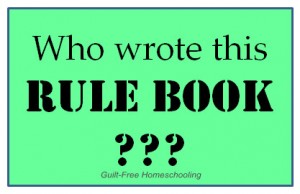It took me a few years to learn how to homeschool. At first, we tried to duplicate school at home. Bad idea. Public school held too many bad memories for my daughter, and she needed to be freed from that bondage. My son had only experienced Kindergarten at the public school, so he did not have as many preconceived ideas of what school was supposed to be like and readily accepted whatever we did.
Each successive year brought new changes for us as we relaxed more and more and allowed formality to drop away in favor of a more comfortable, Guilt-Free style. I stopped keeping a detailed journal of what my students accomplished each day. I developed a check-off chart system for lesson plans that showed where we were in our schedule and made the journal redundant. I relaxed my schedule to allow for unexpected illnesses or unplanned days off. I realized that time off before Christmas is much more valuable than time off after New Year’s. I forced myself to ignore the guilt feelings that came from skipping an uninteresting field trip with our homeschool group. Since my students voluntarily reported on everything they read, we opted to skip the questions at the end of the chapters in science or history and moved on to reading the next chapter. They obviously had learned the material and were just anxious to keep going. We passed over writing assignments in language arts that we felt were especially tedious or irrelevant. I read aloud to my children each day, sometimes several chapters a day when we were in a particularly fascinating book. We kept the learning methods we enjoyed, and we explored other materials for the subjects we detested.
As we began to do school our way, I began to feel more confident. I found myself encouraging other beginning homeschoolers that once you have achieved your second September, you begin to feel like a veteran. You think to yourself, I have done this before. I know how to handle it.
Whenever I caught myself doing something strictly because I thought I was supposed to, without any concrete reason for doing it, I defiantly shouted my new battle cry: “Who wrote this ‘Rule Book’ and why do I think I have to follow it?” It was my own personal declaration of independence. I had realized that there are as many correct ways to homeschool as there are correct reasons to homeschool. I saw that just because someone else teaches in a certain way, it does not mean that my children will benefit from that method as well.
Another facet of this freedom was discovered when my students confirmed my observation that if the teacher and the student are both at the point of tears, it is not the fault of either of them — the curriculum is to blame. The curriculum itself is not necessarily poorly written, it just does not present the material in the way the student will best learn it. I studied learning styles and discovered that students do not all learn in the same ways. When I changed materials and techniques, each student learned better. (Learned, period.) I began tailoring assignments to match each student’s interests and then practically had to step out of their way — it was like adding gasoline to a flame. The right presentation of the material “connects” with the student in such a way as to promote self-teaching. I no longer had to nag or badger — they would eagerly go through the material on their own.
If you or your students are having difficulties in your homeschool, take another look at what “rule book” you are following. Ask yourself if you are doing things in a way that is comfortable and relaxed and fits your family’s lifestyle, or are you going against the natural grain and suffering the guilt and stress of unsuccessful struggles. Discover your reasons for what you teach and how you teach it, then proceed Guilt-Free.



 Guilt-Free Homeschooling is the creation of Carolyn Morrison and her daughter, Jennifer Leonhard. After serious disappointments with public school, Carolyn spent the next 11 years homeschooling her two children, from elementary to high school graduation and college admission. Refusing to force new homeschooling families to re-invent the wheel, Carolyn and Jennifer now share their encouragement, support, tips, and tricks, filling their blog with "all the answers we were looking for as a new-to-homeschooling family" and making this website a valuable resource for parents, not just a daily journal. Guilt-Free Homeschooling -- Equipping Parents for Homeschooling Success!
Guilt-Free Homeschooling is the creation of Carolyn Morrison and her daughter, Jennifer Leonhard. After serious disappointments with public school, Carolyn spent the next 11 years homeschooling her two children, from elementary to high school graduation and college admission. Refusing to force new homeschooling families to re-invent the wheel, Carolyn and Jennifer now share their encouragement, support, tips, and tricks, filling their blog with "all the answers we were looking for as a new-to-homeschooling family" and making this website a valuable resource for parents, not just a daily journal. Guilt-Free Homeschooling -- Equipping Parents for Homeschooling Success!

Speak Your Mind